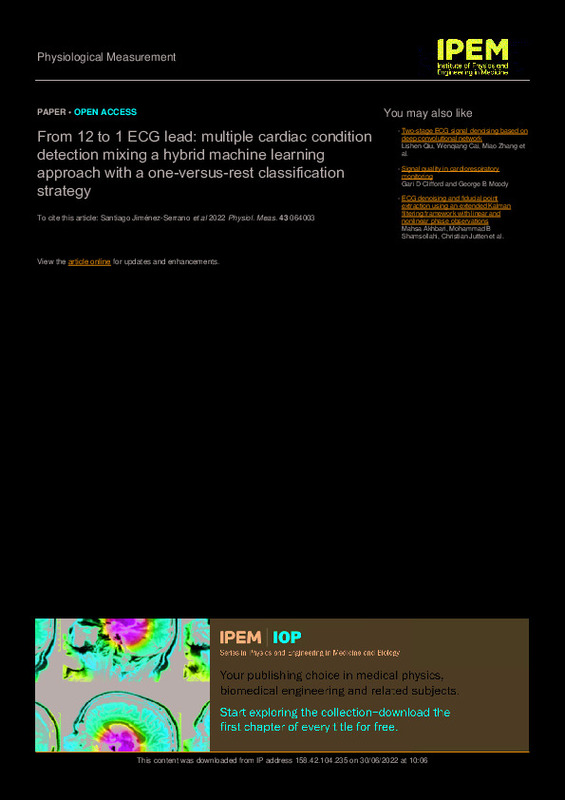JavaScript is disabled for your browser. Some features of this site may not work without it.
Buscar en RiuNet
Listar
Mi cuenta
Estadísticas
Ayuda RiuNet
Admin. UPV
From 12 to 1 ECG lead: multiple cardiac condition detection mixing a hybrid machine learning approach with a one-vs-rest classification strategy
Mostrar el registro sencillo del ítem
Ficheros en el ítem
| dc.contributor.author | Jiménez-Serrano, Santiago
|
es_ES |
| dc.contributor.author | Rodrigo, Miguel
|
es_ES |
| dc.contributor.author | Calvo Saiz, Conrado Javier
|
es_ES |
| dc.contributor.author | Millet Roig, José
|
es_ES |
| dc.contributor.author | Castells, Francisco
|
es_ES |
| dc.date.accessioned | 2023-10-11T18:02:07Z | |
| dc.date.available | 2023-10-11T18:02:07Z | |
| dc.date.issued | 2022-06-30 | es_ES |
| dc.identifier.issn | 0967-3334 | es_ES |
| dc.identifier.uri | http://hdl.handle.net/10251/198022 | |
| dc.description.abstract | [EN] Objective: Detecting different cardiac diseases using a single or reduced number of leads is still challenging. This work aims to provide and validate an automated method able to classify ECG recordings. Performance using complete 12-lead systems, reduced lead sets, and single-lead ECGs is evaluated and compared. Approach: Seven different databases with 12-lead ECGs were provided during the PhysioNet/Computing in Cardiology Challenge 2021, where 88,253 annotated samples associated with none, one, or several cardiac conditions among 26 different classes were released for training, whereas 42,896 hidden samples were used for testing. After signal preprocessing, 81 features per ECG-lead were extracted, mainly based on heart rate variability, QRST patterns and spectral domain. Next, a One-vs-Rest classification approach made of independent binary classifiers for each cardiac condition was trained. This strategy allowed each ECG to be classified as belonging to none, one or several classes. For each class, a classification model among two binary Supervised Classifiers and one Hybrid Unsupervised-Supervised classification system was selected. Finally, we performed a 3-fold cross-validation to assess the system's performance. Main results: Our classifiers received scores of 0.39, 0.38, 0.39, 0.38, and 0.37 for the 12, 6, 4, 3 and 2-lead versions of the hidden test set with the Challenge evaluation metric (CM). Also, we obtained a mean G-score of 0.80, 0.78, 0.79, 0.79, 0.77 and 0.74 for the 12, 6, 4, 3, 2 and 1-lead subsets with the public training set during our 3-fold cross-validation. Significance: We proposed and tested a machine learning approach focused on flexibility for identifying multiple cardiac conditions using one or more ECG leads. Our minimal-lead approach may be beneficial for novel portable or wearable ECG devices used as screening tools, as it can also detect multiple and concurrent cardiac conditions. | es_ES |
| dc.description.sponsorship | This work was supported by PID2019-109547RB-I00 (National Research Program, Ministerio de Ciencia e Innovación, Spanish Government) and CIBERCV CB16/11/00486 (Instituto de Salud Carlos III). | es_ES |
| dc.language | Inglés | es_ES |
| dc.publisher | IOP Publishing | es_ES |
| dc.relation.ispartof | Physiological Measurement | es_ES |
| dc.rights | Reconocimiento (by) | es_ES |
| dc.subject | ECG | es_ES |
| dc.subject | Signal processing | es_ES |
| dc.subject | Feature extraction | es_ES |
| dc.subject | Feature selection | es_ES |
| dc.subject | Machine learning | es_ES |
| dc.subject | Classification | es_ES |
| dc.subject | Cardiac conditions detection | es_ES |
| dc.subject.classification | LENGUAJES Y SISTEMAS INFORMATICOS | es_ES |
| dc.subject.classification | TECNOLOGIA ELECTRONICA | es_ES |
| dc.title | From 12 to 1 ECG lead: multiple cardiac condition detection mixing a hybrid machine learning approach with a one-vs-rest classification strategy | es_ES |
| dc.type | Artículo | es_ES |
| dc.identifier.doi | 10.1088/1361-6579/ac72f5 | es_ES |
| dc.relation.projectID | info:eu-repo/grantAgreement/AEI/Plan Estatal de Investigación Científica y Técnica y de Innovación 2017-2020/PID2019-109547RB-I00/ES/CUANTIFICACION DEL DETERIORO LOCAL DEL MIOCARDIO MEDIANTE CATETER MULTIELECTRODO GRID ALTA DENSIDAD. IDENTIFICACION DE METRICAS DEL SUSTRATO FIBROTICO RESPONSABLE DE ARRITMIAS/ | es_ES |
| dc.relation.projectID | info:eu-repo/grantAgreement/MINECO//CB16%2F11%2F00486/ES/ENFERMEDADES CARDIOVASCULARES/ | es_ES |
| dc.rights.accessRights | Abierto | es_ES |
| dc.contributor.affiliation | Universitat Politècnica de València. Escuela Técnica Superior de Ingenieros Industriales - Escola Tècnica Superior d'Enginyers Industrials | es_ES |
| dc.contributor.affiliation | Universitat Politècnica de València. Escola Tècnica Superior d'Enginyeria Informàtica | es_ES |
| dc.contributor.affiliation | Universitat Politècnica de València. Escuela Técnica Superior de Ingeniería del Diseño - Escola Tècnica Superior d'Enginyeria del Disseny | es_ES |
| dc.contributor.affiliation | Universitat Politècnica de València. Escuela Politécnica Superior de Gandia - Escola Politècnica Superior de Gandia | es_ES |
| dc.contributor.affiliation | Universitat Politècnica de València. Escuela Técnica Superior de Ingenieros de Telecomunicación - Escola Tècnica Superior d'Enginyers de Telecomunicació | es_ES |
| dc.description.bibliographicCitation | Jiménez-Serrano, S.; Rodrigo, M.; Calvo Saiz, CJ.; Millet Roig, J.; Castells, F. (2022). From 12 to 1 ECG lead: multiple cardiac condition detection mixing a hybrid machine learning approach with a one-vs-rest classification strategy. Physiological Measurement. 43(6):1-17. https://doi.org/10.1088/1361-6579/ac72f5 | es_ES |
| dc.description.accrualMethod | S | es_ES |
| dc.relation.publisherversion | https://doi.org/10.1088/1361-6579/ac72f5 | es_ES |
| dc.description.upvformatpinicio | 1 | es_ES |
| dc.description.upvformatpfin | 17 | es_ES |
| dc.type.version | info:eu-repo/semantics/publishedVersion | es_ES |
| dc.description.volume | 43 | es_ES |
| dc.description.issue | 6 | es_ES |
| dc.identifier.pmid | 35609610 | es_ES |
| dc.relation.pasarela | S\465773 | es_ES |
| dc.contributor.funder | Agencia Estatal de Investigación | es_ES |
| dc.contributor.funder | Ministerio de Economía y Competitividad | es_ES |
| upv.costeAPC | 2952,4 | es_ES |








